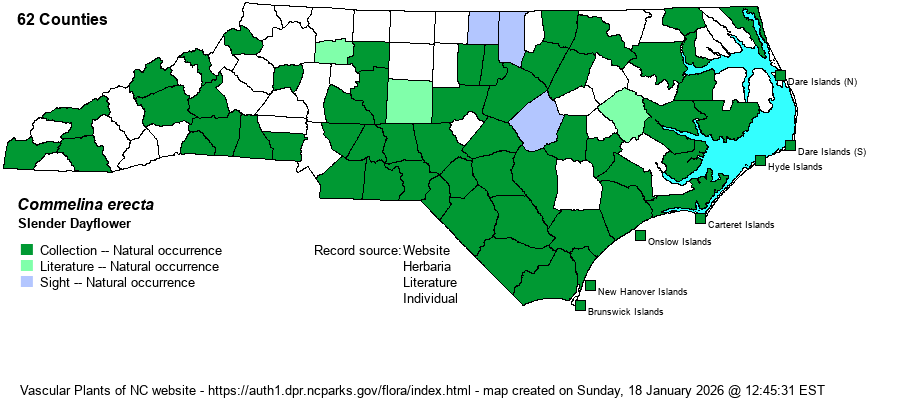| Author | L. | |
| Distribution | Found roughly statewide, but of quite spotty distribution in the northwestern Piedmont and much of the Mountains. Perhaps absent from some northwestern counties in the state.
This is a very wide-ranging species from the Atlantic to nearly the Pacific, ranging north to southeastern PA and SD and south to the Gulf Coast from FL to TX and westward. | |
| Abundance | Fairly common to at least locally common in the southern half of the Coastal Plain, including the Sandhills region. Elsewhere in the northern Coastal Plain and most of the Piedmont it is infrequent to occasionally fairly common. Very rare in the northwestern portion of the state. | |
| Habitat | This species, comprising two varieties in the state, favors dry sites. It occurs in openings in maritime forests, stable dunes, sandy flats, Longleaf Pine-oak-Wiregrass sandhills communities, ledges and rock outcrops, margins of flatrocks, barrens, and other such dry or rocky places. |
| Phenology | Blooms and fruits between June and October. | |
| Identification | This species, though named as "erecta", has leaning to at times erect stems, to about 12-15 inches high. The dark green and fleshy-looking leaves are rather few along the stem; they are narrowly elliptic to lanceolate, entire, and about 4 inches long but about 1 inch wide. At the top of the stem grow several light blue flowers, each consisting of two fairly large and rounded "ears", and one quite small white petal at the bottom appearing like a "chin". The flower measures about 1 inch across. You will note on this and other Commelina species that the flowers grow within or from a large leaf-like or ear-like folded "flap", which is a spathe. Normally one does not have trouble separating this native species from the weedy C. communis, as that exotic species has the upper petals deep blue or rich blue, strongly contrasting with the white lower petal. That species grows in large and dense patches in disturbed ground, and in general it has a somewhat leaning aspect (though this is often not helpful). Another exotic -- C. diffusa -- has all three petals light blue and has the sheath/spathe not fused into a flap. That species does grow in similar sandy places and might appear to be a native, so make sure to see the small white lower petal and the basally fused spathe to be sure you have the native C. erecta. You should be able to find Slender Dayflower along the back sides of dunes, around the margins of Piedmont granitic flatrocks, and various sandhills sites. | |
| Taxonomic Comments | Two varieties occur in the state. C. erecta var. angustifolia is the primary Coastal Plain taxon, with narrower leaves that average about 1/2" wide; whereas C. erecta var. erecta is the one found in the Piedmont and mountains, as well as scattered in the northern Coastal Plain.
| |
| Other Common Name(s) | Whitemouth Dayflower, Erect Dayflower | |
| State Rank | S5 | |
| Global Rank | G5 | |
| State Status | | |
| US Status | | |
| USACE-agcp | FACU link |
| USACE-emp | FAC link |

